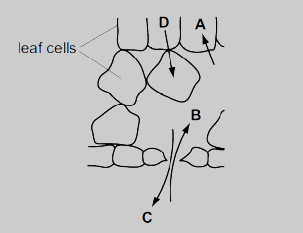
The diagram below shows the part of a section through a leaf.
Which arrow shows the movement of water by osmosis in a leaf?

A. A
B. B
C. C
D. D

Answer
488.4k+ views
Hint: “Osmosis is a process in which solvent molecules move from a low-concentration solution to a high-concentration solution across a semipermeable membrane”. Osmosis is a passive process that occurs without the need of any energy. It entails the migration of molecules from a higher concentration zone to a lower concentration region until the concentrations on both sides are equal.
Complete solution:
Let us introspect each of the options to find the correct arrow which depicts the direction of flow of water through osmosis.
Option: A – The arrow A in the figure does not depict the process of osmosis.
Thus, Option A is incorrect.
Option: B - The arrow B represents gaseous exchange through stomata.
Thus, Option B is not the correct response.
Option: C – The arrow C also represents gaseous exchange through stomata.
Thus, Option C is also not the correct response.
Option: D - Osmosis allows water to pass through cell membranes. The flow of water across a partly permeable membrane from a less concentrated solution to a more concentrated solution is known as osmosis.
As a result, option D is the right response.
Hence, Option D. D is the correct answer
Note:
The capacity of plant roots to take water from the soil is due to osmosis. Plants use active transport to concentrate solutes in their root cells, and osmosis allows water to reach the roots. Osmosis is also responsible for regulating guard cell mobility. Endosmosis in a hypotonic environment causes the cell to become turgid, which helps plants stay rigid, bloated, and upright.
Complete solution:
Let us introspect each of the options to find the correct arrow which depicts the direction of flow of water through osmosis.
Option: A – The arrow A in the figure does not depict the process of osmosis.
Thus, Option A is incorrect.
Option: B - The arrow B represents gaseous exchange through stomata.
Thus, Option B is not the correct response.
Option: C – The arrow C also represents gaseous exchange through stomata.
Thus, Option C is also not the correct response.
Option: D - Osmosis allows water to pass through cell membranes. The flow of water across a partly permeable membrane from a less concentrated solution to a more concentrated solution is known as osmosis.
As a result, option D is the right response.
Hence, Option D. D is the correct answer
Note:
The capacity of plant roots to take water from the soil is due to osmosis. Plants use active transport to concentrate solutes in their root cells, and osmosis allows water to reach the roots. Osmosis is also responsible for regulating guard cell mobility. Endosmosis in a hypotonic environment causes the cell to become turgid, which helps plants stay rigid, bloated, and upright.
Recently Updated Pages
Master Class 11 Economics: Engaging Questions & Answers for Success

Master Class 11 English: Engaging Questions & Answers for Success

Master Class 11 Social Science: Engaging Questions & Answers for Success

Master Class 11 Biology: Engaging Questions & Answers for Success

Class 11 Question and Answer - Your Ultimate Solutions Guide

Master Class 11 Business Studies: Engaging Questions & Answers for Success

Trending doubts
10 examples of friction in our daily life

One Metric ton is equal to kg A 10000 B 1000 C 100 class 11 physics CBSE

Difference Between Prokaryotic Cells and Eukaryotic Cells

1 Quintal is equal to a 110 kg b 10 kg c 100kg d 1000 class 11 physics CBSE

Explain zero factorial class 11 maths CBSE

What is a periderm How does periderm formation take class 11 biology CBSE




